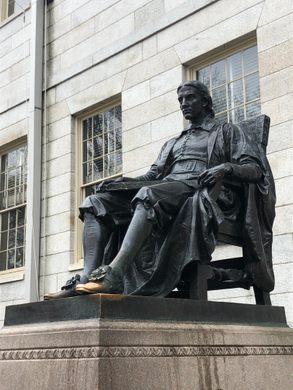John Harvard 'Statue of Three Lies'
The statue of John Harvard isn't actually John Harvard—or even, technically, the founder of the school.
The campus of Harvard University projects a sense of order and continuity, from the brick wall enclosing the historic Yard to the imposing pillars of Widener Library. Yet despite the feeling of solid tradition and genteel propriety which pervades the campus, a storm of myth, controversy, and outright lies has swirled around its “founder’s” monument for more than 100 years.
Things started innocently enough when, in 1883, a supporter of the university offered to commission and donate a statue of the school’s namesake benefactor, John Harvard. Auspiciously, the artist selected for the project was Daniel Chester French, who would later go on to sculpt Lincoln for his memorial in Washington, D.C. Unveiled in 1884, the result was a figure of John Harvard in bronze, holding a book, seated on a granite plinth inscribed “JOHN HARVARD • FOUNDER • 1638.”
Some contemporary observers immediately suggested that this inscription was inaccurate, since John Harvard technically did not found the college in 1638. Rather, the college had been founded in 1636 by an act of the colonial government. Two years later, Harvard bequeathed his library of books and a sum of money to the fledgling college, which was subsequently renamed in his honor.
Further controversy arose from the fact that no image was made of John Harvard during his lifetime, so nobody knew what he looked like. French solved this problem by using a student as his model, whose ancestors had, like Harvard, been involved with the college in its early days.
Although French had taken quite seriously the matter of John Harvard’s unknown image, he worried whether he had made the right creative decision, and as critics attacked, his work became known as “the statue of the three lies.” Contrary to its inscription, it was not a likeness of John Harvard; Harvard did not “found” the school; and the school was founded before 1638.
The university generally has accepted the statue as truthful: John Harvard, although not “the” founder, was “a” founder of the school, and possibly the most important one, by virtue of his significant bequest. Likewise, the sculpted figure is regarded as an “idealization” of Harvard’s values, if not an actual likeness of the man himself. Modern historians defend the statue as well. Insisting there is no myth to be destroyed, one historian called the idea of the three lies “a fourth lie.”
Nevertheless, the three lies have been a staple of Harvard lore for decades, and are still recited today by students and tour guides. There is even a page on the university’s website which bluntly asserts the three lies and mentions no other interpretation.
A separate controversy has settled onto the statue’s left foot, which has been rubbed noticeably smooth and shiny by thousands of passing hands. Some cite an old tradition of students rubbing the shoe for luck; others say there is no such tradition, only a folk tale for gullible tourists. Indeed, an article in the Harvard Crimson celebrating the statue’s 1984 centennial does not mention the left shoe, possibly indicating that this “tradition” is a recent development.
That same Crimson article does describe various other indignities visited upon the statue through the years. John Harvard has been doused with paint in at least two colors: crimson after some notable Harvard athletic triumphs, and Yale blue by saboteurs from New Haven. In the turbulent 1960s, he was draped with protest banners, and in the ’80s he was reportedly decorated with banana peels, for reasons which are now unknown and are likely to remain unfathomable.
The sculptor, French, probably never envisioned all of this tumult when he unveiled his creation, bookish and quietly seated outside Memorial Hall in mute bronze. John Harvard has been moved since then, to his present location outside University Hall, but it seems that commotion and controversy are determined to follow him.
Know Before You Go
The statue is located in Harvard Yard, which is freely open to the public, and is located adjacent to the Harvard station on Boston's MBTA transit system.
Community Contributors
Added by
Edited by
The Atlas Obscura Podcast is Back!
























Follow us on Twitter to get the latest on the world's hidden wonders.
Like us on Facebook to get the latest on the world's hidden wonders.
Follow us on Twitter Like us on Facebook